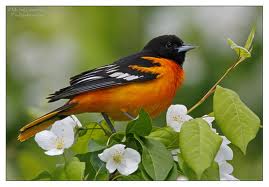Video: Baltimore Oriole In Bermuda Garden
 Elizabeth Lusher woke up last Wednesday [Apr. 3] to discover she had a new — and melodic — neighbour.
Elizabeth Lusher woke up last Wednesday [Apr. 3] to discover she had a new — and melodic — neighbour.
A Baltimore Oriole, a relatively rare North American visitor to Bermuda, had taken up residence in her Pembroke garden.’
“Heard an unusual bird singing outside my window and captured this video of a lone male Baltimore Oriole enjoying the seeds of an unusual, flowering tree there,” she posted.
She continued: “He must have been blown off course during a recent North Atlantic storm. He’s been visiting the same tree for the past few days and hopefully is building up his energy reserves before resuming his journey and rejoining his fellow migrators in the US and Canada.”
The Baltimore Oriole, named because its colours resemble those on Lord Baltimore’s coat-of-arms, is a beautiful bird with bright plumage.
Found along the US East Coast and the state bird of Maryland, the Baltimore Oriole migrates as far south as the shores of the southwestern Gulf of Mexico, all of Florida and as far east as Bermuda in the winter.
These birds have a particularly interesting nest structures. Making their nests in deciduous trees some 25-60 feet off the ground, the nest actually hangs from the end of a branch, almost like a purse hanging on a doorknob. They offer up one set of four eggs per year.
Ekizabeth Lusher’s video of her new, feathered neighbour
Read More About
Category: All, Environment, Videos


I so enjoyed watching the video this morning of your little visitor. Every year around the first part of May we put out oranges, bananas, and nectar for the Baltimore Orioles that migrate through our area. (It has been suggested that we also put meal worms out in a dish for them, but I can’t quite get myself to do that!) It is such a joy to watch them. We hear them before we see them; usually it’s him first and we know his call so we know they’re back! We enjoy their short visits, and love to watch them enjoying their treats on our deck and watching them pop from tree to tree in the back yard. All too soon they’re gone, but we know they have full bellies. Then we prepare for the rest of our feathered visitors over the summer. Such a gift to us to enjoy them and be kind to them. We are so blessed with many sounds, colours and antics over the summer months.
Thanks so much for educating me on my new friend. I read online that Baltimore Orioles are quite social and therefore worried even more that he seemed to be all alone. Whew! I feel so much more at ease about his fate now. Aren’t you lucky (by design, I’m sure) to have many feathered friends visit over the summer. If you have the time/inclination, I’d love to hear of the other migrating birds that visit you so I can look out for them too…
Last week we also sighted this bird in my garden at Southdown Farm Southampton.
I was pleased to read about the bird’s habits as I am not into birds.
You’re into birds now though, aren’t you, Marion? Obviously so…:)
Yes Elizabeth, this bird was so different from the usual Kiskadees, bluebirds and cardinals, which I well know. Southdown Farm is a haven for the birds.
Thanks very much for putting this story on Bernews. I’ve already learned a whole lot from the two respondents, so far…
All the best …
Ms. Lusher, my apologies…I did not mention that I do not live in Bermuda! I read the RG and visit Bernews daily to catch up on the goings on in Bermuda. ( I was born there and still have family living there…) I re-read what I wrote and I can see how you would think I was there. Again, my apologies. Good luck with your oriole!
PS…the one you saw is a male, bright, vibrant orange in colour. The female is “sort” of orangy/drab greenish/brownish. I’d say he’s on his own since he was blown off course. It would be wonderful if there was a female thereabouts, and you could enjoy watching them! She’s the one that makes the nest, (of course) and it’s like a little hanging basket. They winter in Mexico and South America and then migrate up to the US and Canada for the summer. They like berries, meal worms, caterpillars, oranges and bananas, (as I previously mentioned.) Hubby and I spoil our feathered visitors with different varieties of seeds and corn for the migrating mallards.
and it’s like a little hanging basket. They winter in Mexico and South America and then migrate up to the US and Canada for the summer. They like berries, meal worms, caterpillars, oranges and bananas, (as I previously mentioned.) Hubby and I spoil our feathered visitors with different varieties of seeds and corn for the migrating mallards.
BdaBlu – Thanks for the further education. I haven’t heard or seen him in a couple of days now but I will get some oranges and bananas in case he returns….